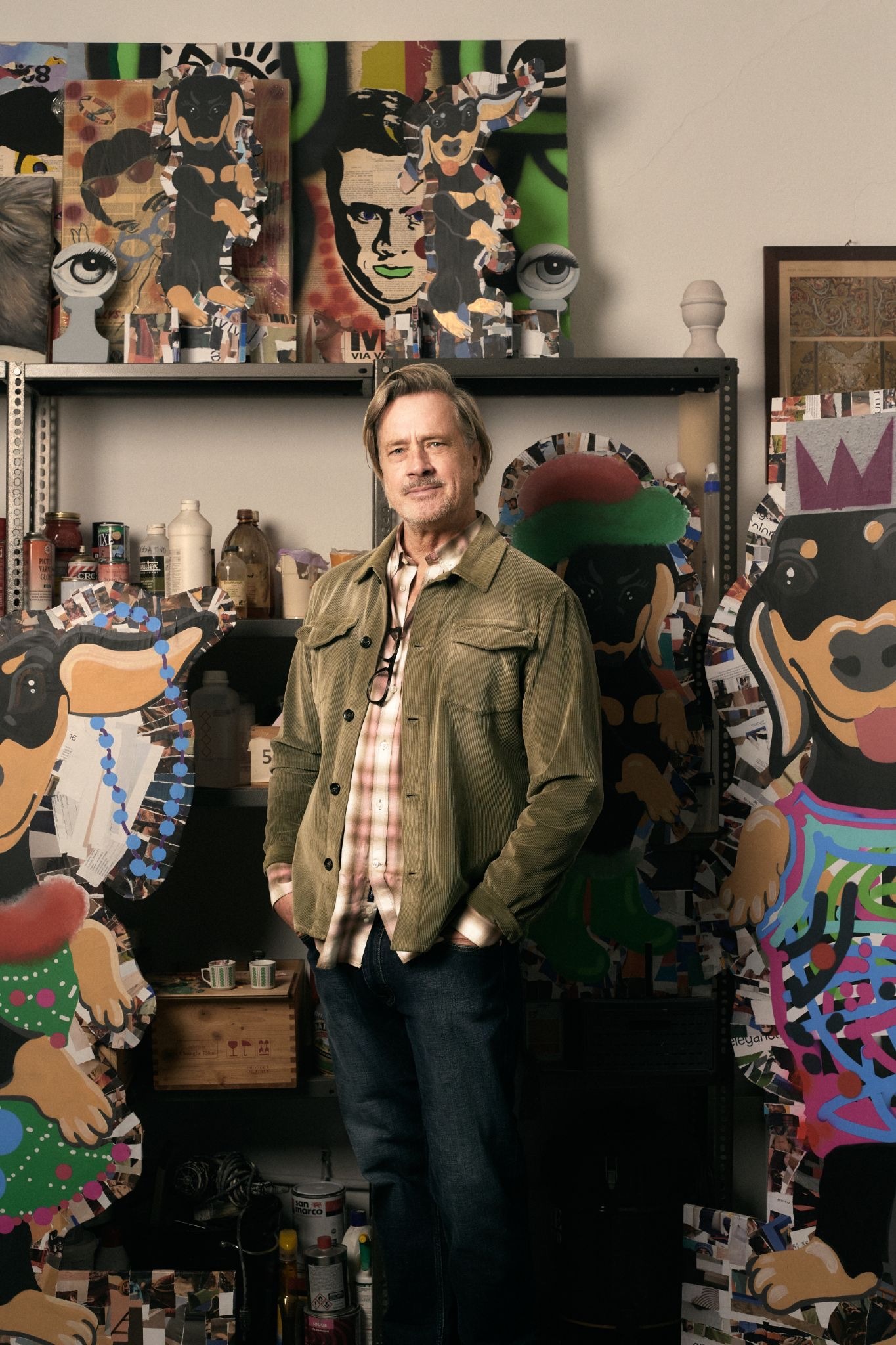



























If This Spam Could Talk: I scored 48% on ‘How much of an adrenal gland are you?’ Rating: Radiohead
Flaunt emails Rob Manuel, the satirical technologist behind self-generating Twitter parody account @ClickbaitRobot
The moral of clickbait's trending story: Just because you’re dying to click it, doesn’t mean it'll take you somewhere worthwhile.
But what if it purposely took you nowhere at all? What if Clickbait titles become the content themselves? What if we didn't even have to write them ourselves, and machines did it instead?
[Clickbait Robot](https://twitter.com/clickbaitrobot) (CBR) is a prototype of this clickless _autotainment_. This program, created by Rob Manuel, uses an algorithm which independently creates “clickable” titles by gluing together words taken from Clickbait articles going viral in real time. The resulting text is applied to a random, sometimes unrelated image, creating a meme.

While potentially compelling, CBR delineates a rejection of the "clickbait" we so often regret clicking—CBR does not link to any article or content (Deleuzanal, so to speak). The titles don’t drive traffic to any website, or generate any advertising revenue. CBR has no interest beyond the laugh accompanying the idea that 23 different ladders might resemble Aleister Crowley.
Comedy requires consciousness. Hearing a joke, and laughing, requires sophisticated intelligence to both split the difference between what is expected versus what is potentially implied, to get it, more or less. Writing a joke is even more challenging as one must identify a gap in logic, and exploit it, via widely accessible language (and have the verve to express it). Writing good comedy is no fool's errand. But CBR's humor stems from its automated and indeterministic nature, traits found in Dada.

Shortly after World War I, a group of artists called themselves Dadaists. They began to argue for art that reflected the absurdity and incomprehensibility of the trauma and suffering in the world around them. The result was a form of art that was illogical and random, and that, despite being born out of serious concerns, often resulted in humorous amusement.
When an editor came across @clickbaitrobot, he found the Twitter feed hilarious, insofar as it appeared to be written by a computer. With interest in the impending Singularity, he tweeted at the account. Rob Manuel liked it, leading to the subsequent email exchange with the creator of CBR.
**Hi, Rob. Thank you for agreeing to this interview. What’s your relationship with clickbait and how does that manifest through your program Clickbait Robot?**
===============================================================================================================================================================
I have a love/hate relationship with clickbait—this project is halfway between a mocking the trending news industry and wondering how to do it better.
I've worked in journalism and running editorial sites—I've been under pressure to get the numbers up, I've seen the pressure put on writers and I've applied that pressure myself.
**How does CBR relieve that pressure?**
=======================================
Clickbait Robot is essentially my version of a newsroom without a budget or staff: find the trending item, apply a formula to it—publish and hope that people share it.
But it's also just a way of doing jokes. I love gens. I love looking at sentence structures and going, "would this be funny if I switched the nouns? Would I get another joke from this?"
**It seems like you’re trolling the idea of clickbait itself. We’re long past being nice to clickbait headlines and their writers, right?**
===========================================================================================================================================
I'd argue I'm not trolling, I'm subtweeting the industry, an industry I've worked in and occasionally still work in.
I wanted to try and build something that surprised me, and I reckoned the way to do that was mix up words and structures I find funny with trending information that I don't control.
And it's also an excuse to geek out and learn some new programming skills.
How does your algorithm work?
=============================
The algorithm works like this:
Every 10 mins or so it checks the trending items on Twitter, removes the hashtags and removes ones that aren't using a Roman alphabet. (It's tricky enough writing jokes, let alone hoping they might work in Arabic)
Then \[the program\] picks from about 50 different templates. Each template is based on a headline I've seen on sites like Buzzfeed, The Telegraph, Upworthy or even sites I've worked on myself.
The simplest (and probably most effective) template is \[X\] that looks like \[Y\]—in this case \[Y\] being the input value from the trending items. Let's imagine it's Ross From Friends. I don't know why he's trending but he is.

Then \[X\] is filled from a long list of random boring objects. Pianos. Bits of string. It's a big list and very mundane, but comparing famous people visually to mundane objects just works. "15 multi-storey carparks that look like Oprah Winfrey" kind of things.

The bot then glues this text together with some images from a Google image search and publishes it to a private twitter account called clickbaitrobot0t.

I, then as editor, hand pick the ones I like by pressing fav and another bit of bot code copies the tweet across to the live account.

Finally, everything is published to Facebook and Tumblr automatically too—natively sticking the images into those systems instead of just linking the tweets. This is an experiment in running my own CMS that's basically "social first" rather than what the industry was saying a couple of years ago, "mobile first."

**I'm interested in the moral issues that emerge. I’m glad to see that there is still a human component to this, it makes me marginally less fearful of a "Singular Clickbait."**
=================================================================================================================================================================================
Hand curating is necessary as a.) there's quite a few boring ones so this keeps the quality higher and b.) mixed in with trends are murder victims etc, and turning them into tasteless clickbait might be some sort of satire about the state of the industry, but I've got no stomach for it so would rather not go down that road.
**What percentage of algorithmically generated clickbait ends up being usable?**
================================================================================
Probably 5%—maybe more but I don’t want to be repetitive.
**Given that there is a human component to the process, couldn’t CBR use an algorithm where it takes into account feedback from smaller and separate audiences to self-edit and nix the boring an unethical content before it going viral? Tldr, if posting \[X\] keeps losing followers, maybe nix all randomly generated posts containing variants of \[X\].**
At the core of it we're talking about pre-moderation. Showing stuff to a few people before showing it to more people.
This is already built into the system—stuff goes to a private account and I moderate it and scaling this is easy because I can take advantage of stuff already in Twitter.
I could invite OTHER people to this account and they can moderate.
Or, I could invite a hundred people to the account and change one line of code to make it so it requires favs >10 \[more than ten favs\] to get copied over the main account.
**Any guess when algorithms will be able to spit out all usable memes (text/image) on its own?**
I dunno when algorithms will be able to spit out usable memes on their own—as said previously—I don't hugely mind if something is mostly wrong, I'm interested in the times something is right.
**Assuming everything became fully automated, and something tasteless emerges, wouldn't it be "our" (the web user's) fault for "voting up" despicable content?**
It only takes watching something like the reactions to the Paris shootings to unfurl on Twitter to make me quite certain that I have no interest in letting a bot run riot without a human acting as gatekeeper.
This isn't to say I think making jokes about tragic events is something no one should do ever—satire in that area should be done carefully by people knowing exactly what they are trying to achieve—rather than some bot blundering in, half-cocked. What are we mocking? And why?

Manuel told us that he was aware of Dada, but that it wasn't a conscious factor in Clickbait Robot's design and execution. But should we even call CBR Dada? Its Dada components—process, randomness, automatism—are used for vastly different means. Is it Post-Dadaist?
Dada sought to remove as much consciousness, rationality, and intentionality as possible from its art, prioritizing chance and accident. By eliminating conscious control on the artistic process and replacing it with aleatoric variables, Dada artists thrived in mediums like the collage, which allowed for greater distance between the hand of the artist and the artwork.
Similarly, CBR uses an impersonal and randomized approach to create digital collages that are absolutely incongruent, with oftentimes hilarious effect. But this doesn't imply equivalence. Dada artists were responding to trauma that they could not make sense of by pursuing meaning and significance in the incongruity of their own art. Although the algorithm mocks the Clickbait phenomenon, CBR also aims to make it more productive by eliminating the human costs associated with its production. Dada went inward to investigate an externalized context. They rejected an increasingly violent and mechanical world, a world they sought to separate from Art. CBR uses an inward tool (the Web), to investigate the collective use of this very tool. The audience is the same people using the tool. Separation would render Manuel's work pointless, ineffective.
And just like Rob realizes his robot does not yet have the capacity to be human, Dadaists realized that humans could not create art that was completely void of intentionality and consciousness, as mechanical as the process might have been. Eventually this realization led Dadaists like André Breton to refocus their efforts of eliminating consciousness, towards an investigation of unconsciousness, thus allowing the inescapable humanity of the artist to regain its role in art with the Surrealist movement.
So, robots cannot yet be human, and humans cannot be robots. Yet, the Clickbait phenomenon in the digital age encourages a robot-like behavior. Insofar as our curiosity and likeliness to click on something can be reduced to a simple algorithm, there's still a question: Are the machines quietly assuming dominance over us? Without intending, might technology's role in shaping our behavior one day exceed our need to shape it?
_All images courtesy Rob Manuel (aka @clickbaitrobot on Twitter)_
 

 

 

 

 

 

 

 

 

 

 

 

 

 
If This Spam Could Talk: I scored 48% on ‘How much of an adrenal gland are you?’ Rating: Radiohead
Flaunt emails Rob Manuel, the satirical technologist behind self-generating Twitter parody account @ClickbaitRobot
The moral of clickbait's trending story: Just because you’re dying to click it, doesn’t mean it'll take you somewhere worthwhile.
But what if it purposely took you nowhere at all? What if Clickbait titles become the content themselves? What if we didn't even have to write them ourselves, and machines did it instead?
[Clickbait Robot](https://twitter.com/clickbaitrobot) (CBR) is a prototype of this clickless _autotainment_. This program, created by Rob Manuel, uses an algorithm which independently creates “clickable” titles by gluing together words taken from Clickbait articles going viral in real time. The resulting text is applied to a random, sometimes unrelated image, creating a meme.

While potentially compelling, CBR delineates a rejection of the "clickbait" we so often regret clicking—CBR does not link to any article or content (Deleuzanal, so to speak). The titles don’t drive traffic to any website, or generate any advertising revenue. CBR has no interest beyond the laugh accompanying the idea that 23 different ladders might resemble Aleister Crowley.
Comedy requires consciousness. Hearing a joke, and laughing, requires sophisticated intelligence to both split the difference between what is expected versus what is potentially implied, to get it, more or less. Writing a joke is even more challenging as one must identify a gap in logic, and exploit it, via widely accessible language (and have the verve to express it). Writing good comedy is no fool's errand. But CBR's humor stems from its automated and indeterministic nature, traits found in Dada.

Shortly after World War I, a group of artists called themselves Dadaists. They began to argue for art that reflected the absurdity and incomprehensibility of the trauma and suffering in the world around them. The result was a form of art that was illogical and random, and that, despite being born out of serious concerns, often resulted in humorous amusement.
When an editor came across @clickbaitrobot, he found the Twitter feed hilarious, insofar as it appeared to be written by a computer. With interest in the impending Singularity, he tweeted at the account. Rob Manuel liked it, leading to the subsequent email exchange with the creator of CBR.
**Hi, Rob. Thank you for agreeing to this interview. What’s your relationship with clickbait and how does that manifest through your program Clickbait Robot?**
===============================================================================================================================================================
I have a love/hate relationship with clickbait—this project is halfway between a mocking the trending news industry and wondering how to do it better.
I've worked in journalism and running editorial sites—I've been under pressure to get the numbers up, I've seen the pressure put on writers and I've applied that pressure myself.
**How does CBR relieve that pressure?**
=======================================
Clickbait Robot is essentially my version of a newsroom without a budget or staff: find the trending item, apply a formula to it—publish and hope that people share it.
But it's also just a way of doing jokes. I love gens. I love looking at sentence structures and going, "would this be funny if I switched the nouns? Would I get another joke from this?"
**It seems like you’re trolling the idea of clickbait itself. We’re long past being nice to clickbait headlines and their writers, right?**
===========================================================================================================================================
I'd argue I'm not trolling, I'm subtweeting the industry, an industry I've worked in and occasionally still work in.
I wanted to try and build something that surprised me, and I reckoned the way to do that was mix up words and structures I find funny with trending information that I don't control.
And it's also an excuse to geek out and learn some new programming skills.
How does your algorithm work?
=============================
The algorithm works like this:
Every 10 mins or so it checks the trending items on Twitter, removes the hashtags and removes ones that aren't using a Roman alphabet. (It's tricky enough writing jokes, let alone hoping they might work in Arabic)
Then \[the program\] picks from about 50 different templates. Each template is based on a headline I've seen on sites like Buzzfeed, The Telegraph, Upworthy or even sites I've worked on myself.
The simplest (and probably most effective) template is \[X\] that looks like \[Y\]—in this case \[Y\] being the input value from the trending items. Let's imagine it's Ross From Friends. I don't know why he's trending but he is.

Then \[X\] is filled from a long list of random boring objects. Pianos. Bits of string. It's a big list and very mundane, but comparing famous people visually to mundane objects just works. "15 multi-storey carparks that look like Oprah Winfrey" kind of things.

The bot then glues this text together with some images from a Google image search and publishes it to a private twitter account called clickbaitrobot0t.

I, then as editor, hand pick the ones I like by pressing fav and another bit of bot code copies the tweet across to the live account.

Finally, everything is published to Facebook and Tumblr automatically too—natively sticking the images into those systems instead of just linking the tweets. This is an experiment in running my own CMS that's basically "social first" rather than what the industry was saying a couple of years ago, "mobile first."

**I'm interested in the moral issues that emerge. I’m glad to see that there is still a human component to this, it makes me marginally less fearful of a "Singular Clickbait."**
=================================================================================================================================================================================
Hand curating is necessary as a.) there's quite a few boring ones so this keeps the quality higher and b.) mixed in with trends are murder victims etc, and turning them into tasteless clickbait might be some sort of satire about the state of the industry, but I've got no stomach for it so would rather not go down that road.
**What percentage of algorithmically generated clickbait ends up being usable?**
================================================================================
Probably 5%—maybe more but I don’t want to be repetitive.
**Given that there is a human component to the process, couldn’t CBR use an algorithm where it takes into account feedback from smaller and separate audiences to self-edit and nix the boring an unethical content before it going viral? Tldr, if posting \[X\] keeps losing followers, maybe nix all randomly generated posts containing variants of \[X\].**
At the core of it we're talking about pre-moderation. Showing stuff to a few people before showing it to more people.
This is already built into the system—stuff goes to a private account and I moderate it and scaling this is easy because I can take advantage of stuff already in Twitter.
I could invite OTHER people to this account and they can moderate.
Or, I could invite a hundred people to the account and change one line of code to make it so it requires favs >10 \[more than ten favs\] to get copied over the main account.
**Any guess when algorithms will be able to spit out all usable memes (text/image) on its own?**
I dunno when algorithms will be able to spit out usable memes on their own—as said previously—I don't hugely mind if something is mostly wrong, I'm interested in the times something is right.
**Assuming everything became fully automated, and something tasteless emerges, wouldn't it be "our" (the web user's) fault for "voting up" despicable content?**
It only takes watching something like the reactions to the Paris shootings to unfurl on Twitter to make me quite certain that I have no interest in letting a bot run riot without a human acting as gatekeeper.
This isn't to say I think making jokes about tragic events is something no one should do ever—satire in that area should be done carefully by people knowing exactly what they are trying to achieve—rather than some bot blundering in, half-cocked. What are we mocking? And why?

Manuel told us that he was aware of Dada, but that it wasn't a conscious factor in Clickbait Robot's design and execution. But should we even call CBR Dada? Its Dada components—process, randomness, automatism—are used for vastly different means. Is it Post-Dadaist?
Dada sought to remove as much consciousness, rationality, and intentionality as possible from its art, prioritizing chance and accident. By eliminating conscious control on the artistic process and replacing it with aleatoric variables, Dada artists thrived in mediums like the collage, which allowed for greater distance between the hand of the artist and the artwork.
Similarly, CBR uses an impersonal and randomized approach to create digital collages that are absolutely incongruent, with oftentimes hilarious effect. But this doesn't imply equivalence. Dada artists were responding to trauma that they could not make sense of by pursuing meaning and significance in the incongruity of their own art. Although the algorithm mocks the Clickbait phenomenon, CBR also aims to make it more productive by eliminating the human costs associated with its production. Dada went inward to investigate an externalized context. They rejected an increasingly violent and mechanical world, a world they sought to separate from Art. CBR uses an inward tool (the Web), to investigate the collective use of this very tool. The audience is the same people using the tool. Separation would render Manuel's work pointless, ineffective.
And just like Rob realizes his robot does not yet have the capacity to be human, Dadaists realized that humans could not create art that was completely void of intentionality and consciousness, as mechanical as the process might have been. Eventually this realization led Dadaists like André Breton to refocus their efforts of eliminating consciousness, towards an investigation of unconsciousness, thus allowing the inescapable humanity of the artist to regain its role in art with the Surrealist movement.
So, robots cannot yet be human, and humans cannot be robots. Yet, the Clickbait phenomenon in the digital age encourages a robot-like behavior. Insofar as our curiosity and likeliness to click on something can be reduced to a simple algorithm, there's still a question: Are the machines quietly assuming dominance over us? Without intending, might technology's role in shaping our behavior one day exceed our need to shape it?
_All images courtesy Rob Manuel (aka @clickbaitrobot on Twitter)_

If This Spam Could Talk: I scored 48% on ‘How much of an adrenal gland are you?’ Rating: Radiohead
Flaunt emails Rob Manuel, the satirical technologist behind self-generating Twitter parody account @ClickbaitRobot
The moral of clickbait's trending story: Just because you’re dying to click it, doesn’t mean it'll take you somewhere worthwhile.
But what if it purposely took you nowhere at all? What if Clickbait titles become the content themselves? What if we didn't even have to write them ourselves, and machines did it instead?
[Clickbait Robot](https://twitter.com/clickbaitrobot) (CBR) is a prototype of this clickless _autotainment_. This program, created by Rob Manuel, uses an algorithm which independently creates “clickable” titles by gluing together words taken from Clickbait articles going viral in real time. The resulting text is applied to a random, sometimes unrelated image, creating a meme.

While potentially compelling, CBR delineates a rejection of the "clickbait" we so often regret clicking—CBR does not link to any article or content (Deleuzanal, so to speak). The titles don’t drive traffic to any website, or generate any advertising revenue. CBR has no interest beyond the laugh accompanying the idea that 23 different ladders might resemble Aleister Crowley.
Comedy requires consciousness. Hearing a joke, and laughing, requires sophisticated intelligence to both split the difference between what is expected versus what is potentially implied, to get it, more or less. Writing a joke is even more challenging as one must identify a gap in logic, and exploit it, via widely accessible language (and have the verve to express it). Writing good comedy is no fool's errand. But CBR's humor stems from its automated and indeterministic nature, traits found in Dada.

Shortly after World War I, a group of artists called themselves Dadaists. They began to argue for art that reflected the absurdity and incomprehensibility of the trauma and suffering in the world around them. The result was a form of art that was illogical and random, and that, despite being born out of serious concerns, often resulted in humorous amusement.
When an editor came across @clickbaitrobot, he found the Twitter feed hilarious, insofar as it appeared to be written by a computer. With interest in the impending Singularity, he tweeted at the account. Rob Manuel liked it, leading to the subsequent email exchange with the creator of CBR.
**Hi, Rob. Thank you for agreeing to this interview. What’s your relationship with clickbait and how does that manifest through your program Clickbait Robot?**
===============================================================================================================================================================
I have a love/hate relationship with clickbait—this project is halfway between a mocking the trending news industry and wondering how to do it better.
I've worked in journalism and running editorial sites—I've been under pressure to get the numbers up, I've seen the pressure put on writers and I've applied that pressure myself.
**How does CBR relieve that pressure?**
=======================================
Clickbait Robot is essentially my version of a newsroom without a budget or staff: find the trending item, apply a formula to it—publish and hope that people share it.
But it's also just a way of doing jokes. I love gens. I love looking at sentence structures and going, "would this be funny if I switched the nouns? Would I get another joke from this?"
**It seems like you’re trolling the idea of clickbait itself. We’re long past being nice to clickbait headlines and their writers, right?**
===========================================================================================================================================
I'd argue I'm not trolling, I'm subtweeting the industry, an industry I've worked in and occasionally still work in.
I wanted to try and build something that surprised me, and I reckoned the way to do that was mix up words and structures I find funny with trending information that I don't control.
And it's also an excuse to geek out and learn some new programming skills.
How does your algorithm work?
=============================
The algorithm works like this:
Every 10 mins or so it checks the trending items on Twitter, removes the hashtags and removes ones that aren't using a Roman alphabet. (It's tricky enough writing jokes, let alone hoping they might work in Arabic)
Then \[the program\] picks from about 50 different templates. Each template is based on a headline I've seen on sites like Buzzfeed, The Telegraph, Upworthy or even sites I've worked on myself.
The simplest (and probably most effective) template is \[X\] that looks like \[Y\]—in this case \[Y\] being the input value from the trending items. Let's imagine it's Ross From Friends. I don't know why he's trending but he is.

Then \[X\] is filled from a long list of random boring objects. Pianos. Bits of string. It's a big list and very mundane, but comparing famous people visually to mundane objects just works. "15 multi-storey carparks that look like Oprah Winfrey" kind of things.

The bot then glues this text together with some images from a Google image search and publishes it to a private twitter account called clickbaitrobot0t.

I, then as editor, hand pick the ones I like by pressing fav and another bit of bot code copies the tweet across to the live account.

Finally, everything is published to Facebook and Tumblr automatically too—natively sticking the images into those systems instead of just linking the tweets. This is an experiment in running my own CMS that's basically "social first" rather than what the industry was saying a couple of years ago, "mobile first."

**I'm interested in the moral issues that emerge. I’m glad to see that there is still a human component to this, it makes me marginally less fearful of a "Singular Clickbait."**
=================================================================================================================================================================================
Hand curating is necessary as a.) there's quite a few boring ones so this keeps the quality higher and b.) mixed in with trends are murder victims etc, and turning them into tasteless clickbait might be some sort of satire about the state of the industry, but I've got no stomach for it so would rather not go down that road.
**What percentage of algorithmically generated clickbait ends up being usable?**
================================================================================
Probably 5%—maybe more but I don’t want to be repetitive.
**Given that there is a human component to the process, couldn’t CBR use an algorithm where it takes into account feedback from smaller and separate audiences to self-edit and nix the boring an unethical content before it going viral? Tldr, if posting \[X\] keeps losing followers, maybe nix all randomly generated posts containing variants of \[X\].**
At the core of it we're talking about pre-moderation. Showing stuff to a few people before showing it to more people.
This is already built into the system—stuff goes to a private account and I moderate it and scaling this is easy because I can take advantage of stuff already in Twitter.
I could invite OTHER people to this account and they can moderate.
Or, I could invite a hundred people to the account and change one line of code to make it so it requires favs >10 \[more than ten favs\] to get copied over the main account.
**Any guess when algorithms will be able to spit out all usable memes (text/image) on its own?**
I dunno when algorithms will be able to spit out usable memes on their own—as said previously—I don't hugely mind if something is mostly wrong, I'm interested in the times something is right.
**Assuming everything became fully automated, and something tasteless emerges, wouldn't it be "our" (the web user's) fault for "voting up" despicable content?**
It only takes watching something like the reactions to the Paris shootings to unfurl on Twitter to make me quite certain that I have no interest in letting a bot run riot without a human acting as gatekeeper.
This isn't to say I think making jokes about tragic events is something no one should do ever—satire in that area should be done carefully by people knowing exactly what they are trying to achieve—rather than some bot blundering in, half-cocked. What are we mocking? And why?

Manuel told us that he was aware of Dada, but that it wasn't a conscious factor in Clickbait Robot's design and execution. But should we even call CBR Dada? Its Dada components—process, randomness, automatism—are used for vastly different means. Is it Post-Dadaist?
Dada sought to remove as much consciousness, rationality, and intentionality as possible from its art, prioritizing chance and accident. By eliminating conscious control on the artistic process and replacing it with aleatoric variables, Dada artists thrived in mediums like the collage, which allowed for greater distance between the hand of the artist and the artwork.
Similarly, CBR uses an impersonal and randomized approach to create digital collages that are absolutely incongruent, with oftentimes hilarious effect. But this doesn't imply equivalence. Dada artists were responding to trauma that they could not make sense of by pursuing meaning and significance in the incongruity of their own art. Although the algorithm mocks the Clickbait phenomenon, CBR also aims to make it more productive by eliminating the human costs associated with its production. Dada went inward to investigate an externalized context. They rejected an increasingly violent and mechanical world, a world they sought to separate from Art. CBR uses an inward tool (the Web), to investigate the collective use of this very tool. The audience is the same people using the tool. Separation would render Manuel's work pointless, ineffective.
And just like Rob realizes his robot does not yet have the capacity to be human, Dadaists realized that humans could not create art that was completely void of intentionality and consciousness, as mechanical as the process might have been. Eventually this realization led Dadaists like André Breton to refocus their efforts of eliminating consciousness, towards an investigation of unconsciousness, thus allowing the inescapable humanity of the artist to regain its role in art with the Surrealist movement.
So, robots cannot yet be human, and humans cannot be robots. Yet, the Clickbait phenomenon in the digital age encourages a robot-like behavior. Insofar as our curiosity and likeliness to click on something can be reduced to a simple algorithm, there's still a question: Are the machines quietly assuming dominance over us? Without intending, might technology's role in shaping our behavior one day exceed our need to shape it?
_All images courtesy Rob Manuel (aka @clickbaitrobot on Twitter)_









.JPG)
.jpg)







